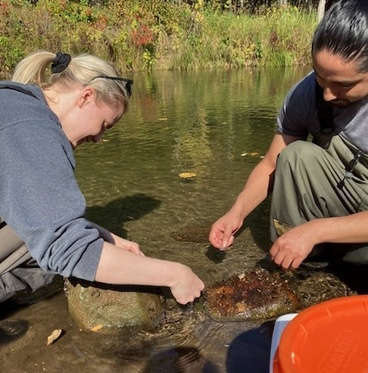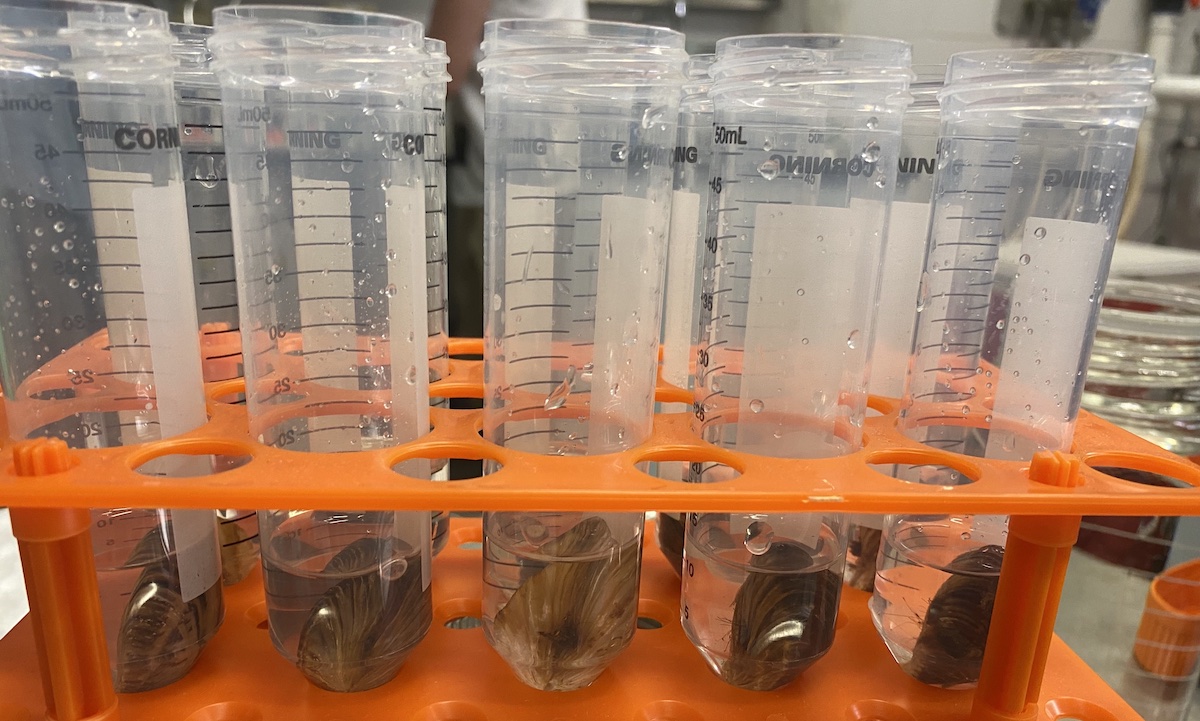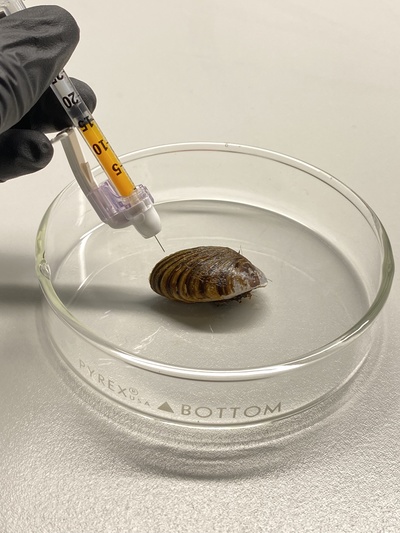Building tools for zebra mussel genetic biocontrol
December 7, 2023
Zebra mussels are a damaging invasive species that are spreading throughout the lakes and rivers of Minnesota and beyond. The UMGC Innovation Lab is building on previous work sequencing the zebra mussel genome and working to develop highly specific genetic biocontrol tools for zebra mussels.
While genetic biocontrol methods have been successfully applied in certain settings (for instance, agricultural pest control for many decades), the development of new genetic tools such as CRISPR-based gene drives has ignited broad interest in the potential to use genetic methods to control human disease vectors and invasive species.
Advancing research through collaborations
Scientists in the UMGC Innovation Lab are collaborating with a number of different research groups to build tools for zebra mussel genetic biocontrol. Over the past several years, they have worked with invasive mussel researcher, Michael McCartney, and molecular biologist, Scott Ballantyne at the University of Wisconsin - River Falls, on a project which aims to use RNA interference induced by dsRNA expressing microbes to knock down the expression of zebra mussel target genes.
This team has been working on establishing assays to assess health and reproduction in zebra mussels, an important milestone for being able to quantify the effects of genetic manipulation. In addition, over the past year, UMGC Innovation Lab scientists Lindsey O'Brien and Victor Hernandez Elizarraga have developed methods to deliver dsRNA to zebra mussel tissue by injection in order to demonstrate RNAi-mediated knockdown of zebra mussel genes.
Raising zebra mussels in the lab
A major challenge in working with zebra mussels is that despite their robust reproduction in the wild, it is not currently possible to grow zebra mussels for multiple generations in the lab. UMGC Innovation Lab scientists are working with Ben Minerich from the Minnesota Zoo on optimizing zebra mussel diet and culture conditions. If successful, this work could lay the groundwork for employing other genetic biocontrol strategies based on manipulating the zebra mussel genome.
RNAi tools to impair the function of genes
Recently, the UMGC Innovation Lab has partnered with scientists at the USGS Columbia Environmental Research Center and this collaborative team has received a grant from the Department of Defense's Strategic Environmental Research and Development Program. This collaboration will use laboratory studies to develop RNAi tools to impair the function of genes critical for zebra mussel fitness, with the goal of developing effective targeting dsRNA and microbial delivery vectors that could allow practical field application in the future.
Recent publication on genetic biocontrol
In a review article published in iScience, Innovation Lab scientists and other groups summarize the existing methods for genetic biocontrol and the efforts to apply these tools to control freshwater invasive mussels. The paper discusses the many challenges to developing effective, specific, and safe genetic biocontrol tools through collaborative interactions amongst our groups and by employing diverse, multidisciplinary approaches.
About the Innovation Lab
The Innovation Lab at the University of Minnesota Genomics Center is a research group founded over four years ago that focuses on the development of novel genomics research tools. Led by Dr. Daryl Gohl, the Innovation Lab aims to establish an externally-funded research program by obtaining independent and collaborative grants from the NIH, NSF, and other agencies.
More work by the Innovation Lab:
- Rational probe design for efficient rRNA depletion and improved metatranscriptomic analysis of human microbiomes. Asako Tan, Senthil Murugapiran, Alaya Mikalauskas, Jeff Koble, Drew Kennedy, Fred Hyde, Victor Ruotti, Emily Law, Jordan Jensen, Gary P. Schroth, Jean M. Macklaim, Scott Kuersten, Brice LeFrançois, Daryl M. Gohl. BMC Microbiology, doi.org/10.1186/s12866-023-03037-y. 2023 Oct 20.
- Variability and Bias in Microbiome Metagenomic Sequencing: an Interlaboratory Study Comparing Experimental Protocols. Samuel P. Forry, Stephanie L. Servetas, Jason G. Kralj, Keng Soh, Michalis Hadjithomas, Raul Cano, Martha Carlin, Maria G de Amorim, Benjamin Auch, Matthew G Bakker, Thais F Bartelli, Juan P. Bustamante, Ignacio Cassol, Mauricio Chalita, Emmanuel Dias-Neto, Aaron Del Duca, Daryl M. Gohl, et al. bioRxiv, doi.org/10.1101/2023.04.28.538741. 2023 May 3.
- A machine vision guided robot for fully automated embryonic microinjection. Andrew D. Alegria, Amey S. Joshi, Jorge Blanco Mendana, Kanav Khosla, Kieran T. Smith, Benjamin Auch, Margaret Donovan, John Bischof, Daryl M. Gohl, Suhasa B. Kodandaramaiahh Dr. bioRxiv, doi.org/10.1101/2023.04.25.538280. 2023 Apr 25.


